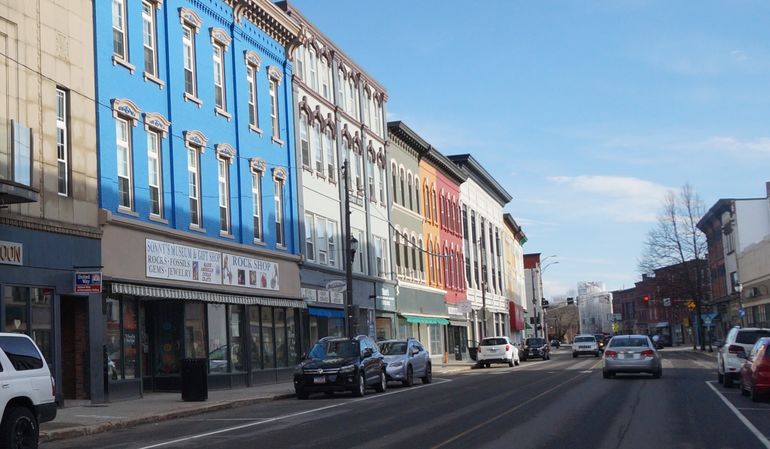
Augusta downtown street reconstruction named Maine's top project
 Photo / Maureen Milliken
The stretch of Water Street in Augusta between Bridge and Winthrop streets had been one-way since 1947. Now, southbound traffic can travel on it too, opening up downtown. The project was named "2020 Project of the Year" by the Maine Association of Planners.
Photo / Maureen Milliken
The stretch of Water Street in Augusta between Bridge and Winthrop streets had been one-way since 1947. Now, southbound traffic can travel on it too, opening up downtown. The project was named "2020 Project of the Year" by the Maine Association of Planners.
A street reconstruction that turned around a 70-year traffic pattern and opened downtown Augusta in a way that hadn't been seen for more than a generation has been recognized as "Project of the Year" by the Maine Association of Planners.
The association cited the detailed planning that went into joining two separate street projects, the information campaign to get drivers and businesses used to new traffic patterns and the continuing commitment by the city to revitalizing downtown.
Other MAP 2020 award winners are the Maine Mall Transit-Oriented Development Concept Plan as "Plan of the Year," and David Nadeau, of Windham, as "Citizen Planner of the Year."
Of the Augusta project, MAP said, "The process for achieving the downtown redesign is a model for other communities. The planning team worked simultaneously on several fronts. They coordinated public outreach, professional engineering studies and landscape design to create a solution that worked technically, aesthetically and politically."
Partners named in the award are the city of Augusta development services, public works and city manager’s office; Maine Traffic Resources, of Gardiner, which did an extensive feasibility analysis; and Desman Design Management, which undertook a downtown parking study as part of the project.

Changing the urban fabric
The two-way change may seem small by some bigger-city standards — the length of street changed was two blocks — but in scale, it's huge for the small downtown. The business district is a compact area, and Water Street is its only thoroughfare. The downtown business district is less than half a mile long, and hemmed in on one side by the Kennebec River and the other by a steep hill.
The two one-way blocks in the heart of the district are key to how downtown is experienced.
"It completely changes the urban fabric of downtown," Matt Nazar, city director of development services, said of the change. "It allows people to move around and get where they want to go."

The project included making the section of Water Street from Bridge Street to Winthrop Street two-way, where it had previously been northbound only. Once that opened, in August 2019, the city reconstructed Commercial Street between the same two streets, which runs behind the businesses on the west side of the street and is remaining one-way southbound.
The $2 million Commercial Street part of the project included upgrading parking, lighting and the street itself. The $200,000 Water Street part was simpler, including street striping and arrows, new parking and improvements for accessibility.
The change is particularly important for visitors, who previously had to navigate the one-way pattern, and opens up downtown in a new way, Nazar said.
Water Street, downtown's main commercial thoroughfare, and parallel Commercial Street, had been one-way since 1945. In recent years, as downtown has made a commercial and residential comeback, businesses have pushed for Water Street to go back to two-way.
The traffic study for the project suggested the move would not only increase traffic, but spur more visits to businesses. “Current traffic patterns push traffic through and around downtown rather than invite customers to the shops, restaurants, cultural venues and businesses that are its lifeblood," the study said.
A range of studies show that a major benefit to two-way downtown main streets is a decrease in commercial vacancies. That’s key to Augusta's revitalization. Despite a growing number of businesses on once-sleepy Water Street, an inventory in 2018 by the city's economic development department shows there were 14 vacancies or unused storefronts in the one-way zone.
Keith Luke, Augusta economic development director, said that with the pandemic, which began five months after the Water Street change was made, it's hard to gauge the effect on businesses, but the impact felt was almost immediate.
"Probably the best metric is that, between the conversion to two-way in the summer of 2019 and the onset of the pandemic, there was a modern era record number of restaurants open on Water Street," he said. The eight restaurants on the two-block stretch are Riverfront BBQ, Otto’s on the River, Cushnoc Brewing, Oak Table, Raging Bull, Huiskamer Coffee, Downtown Diner and Lisa’s Legit Burritos.

Small project, big impact
Nazar told Mainebiz Wednesday that changing traffic patterns tends to be a complex project. "But [Water Street] was pretty darn easy."
That said, it's probably the largest in impact of any traffic reconfiguration the city had done. Large projects in the past were construction of the Cushnoc Bridge and Route 3 extension, which allowed traffic traveling to Belfast and the coast to bypass downtown and opening Exit 113 from Interstate 95 in north Augusta.
"But this is far away the biggest change in the urban fabric of the city," he said.
The work on both streets was done by Sargent Corp., of Old Town. While the project itself was smooth sailing, it came after years of planning that involved several city departments, local consultants, business owners and the Augusta Downtown Alliance.
As part of the planning process, the Augusta city council commissioned the a traffic study by Maine Traffic Resources. It was the study that helped determine Commercial Street needed work and the two projects should be joined.
The city also focused on a public information campaign that would be needed to turn around a lifetime of driving habit for the city's residents. The city worked with Marshall Communications on a public awareness campaign that included message development, advertisements and media relations.
The detailed research and creative planning process were among the reasons cited the Maine Association of Planners for the award.
When the streets were made one-way, the Bridge Street bridge over the Kennebec River was the only way for travelers in central Maine to get across to go east to Belfast and other coastal points. Through-traffic was backing up on Water Street and having a negative impact on businesses. In the years since, Memorial Bridge opened, routing traffic away from downtown, the the Cushnoc Bridge opened in 2005, allowing traffic to get onto Route 3 without going through the middle of the city.
Nazar sees the irony in the origins of the one-way street and the change made last year. Before, people were trying to get through downtown to go somewhere else. "Now it's a destination," he said.

2020 Plan of the Year
The Maine Mall Transit-Oriented Development Concept Plan, the 2020 "Plan of the Year," seeks to build on the successes of transit-oriented development, encouraging residential and mixed-use development where transportation services are feasible, according to the MAP award announcement.
The Portland Area Comprehensive Transportation System identified the mall as one of six priority centers in South Portland for transit-oriented development. Key features of that kind of developer are increasing the supply of single and multifamily housing close to the center of employment and close to transit services.
The plan is an example of working toward a long-range vision in an incentive-based planning environment, MAP said. It's "an attempt to reimagine the mall and show what is possible. It is not meant to be a prescriptive development plan, but rather to serve as a conversation starter, and as a resource for South Portland, PACTS, and other municipalities for future planning and development efforts in priority centers.”
Partners in the Maine Mall Transit-Oriented Development Concept Plan are the city of South Portland, Greater Portland Council of Governments, Richardson and Associates, Portland Area Comprehensive Transportation System, Maine Department of Transportation, Maine Mall management and Long Creek Watershed Management District.
Citizen Planner of the Year

In naming Nadeau 2020 "Citizen Planner of the Year," MAP said that his work exemplifies the practices of time and dedication that increase understanding of planning principles, planning process and organization’s goals, promoting the cause and advancing the merits of planning.
Nadeau has been a member of the Windham Town Council, its planning board, and is a past chair of both, as well as comprehensive plan, land use and other town committees.
He received widespread praise for his dedication to local planning over many years and in many capacities, MAP said, including championing commercial design standards, diversification of municipal revenue sources and mentoring staff and volunteers.










0 Comments